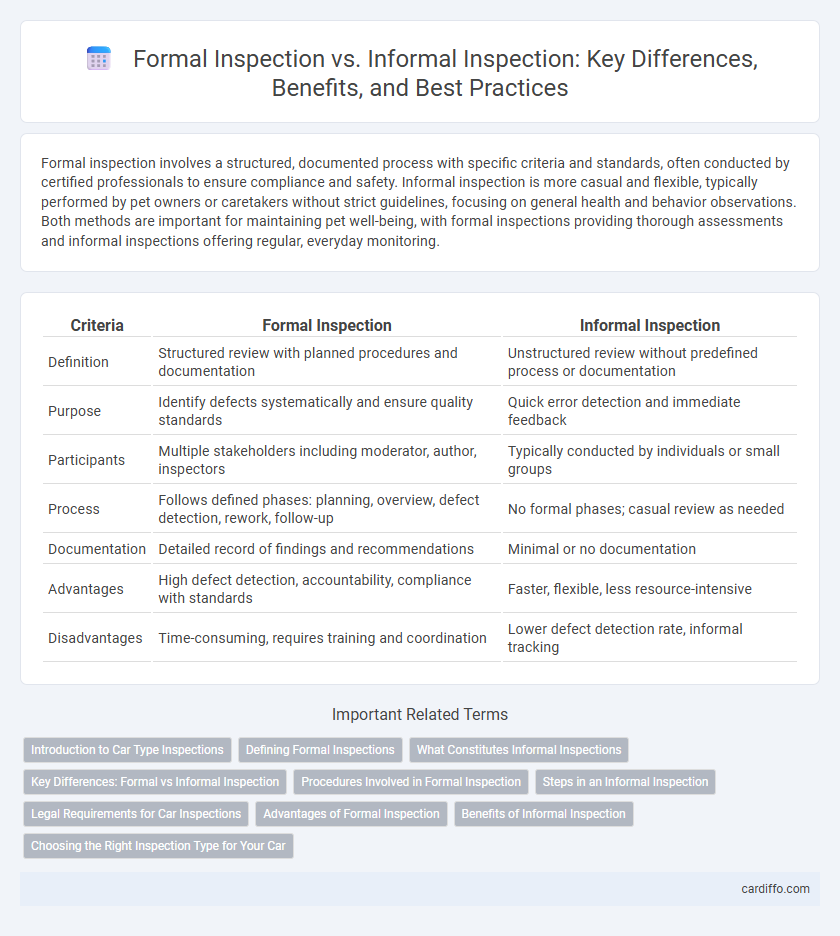Formal inspection involves a structured, documented process with specific criteria and standards, often conducted by certified professionals to ensure compliance and safety. Informal inspection is more casual and flexible, typically performed by pet owners or caretakers without strict guidelines, focusing on general health and behavior observations. Both methods are important for maintaining pet well-being, with formal inspections providing thorough assessments and informal inspections offering regular, everyday monitoring.
Table of Comparison
| Criteria | Formal Inspection | Informal Inspection |
|---|---|---|
| Definition | Structured review with planned procedures and documentation | Unstructured review without predefined process or documentation |
| Purpose | Identify defects systematically and ensure quality standards | Quick error detection and immediate feedback |
| Participants | Multiple stakeholders including moderator, author, inspectors | Typically conducted by individuals or small groups |
| Process | Follows defined phases: planning, overview, defect detection, rework, follow-up | No formal phases; casual review as needed |
| Documentation | Detailed record of findings and recommendations | Minimal or no documentation |
| Advantages | High defect detection, accountability, compliance with standards | Faster, flexible, less resource-intensive |
| Disadvantages | Time-consuming, requires training and coordination | Lower defect detection rate, informal tracking |
Introduction to Car Type Inspections
Car type inspections vary significantly between formal and informal methods, affecting the accuracy and thoroughness of vehicle evaluation. Formal inspections follow standardized protocols, often required by regulatory bodies, ensuring comprehensive checks of safety, emissions, and mechanical components. Informal inspections rely on visual assessments and basic functionality tests, suitable for preliminary evaluations but less reliable for compliance or detailed diagnostics.
Defining Formal Inspections
Formal inspections involve a structured process with predefined roles, checklists, and documented results to ensure thorough evaluation and accountability. These inspections follow strict guidelines and standard operating procedures to systematically identify defects or non-compliance in products or processes. The formal inspection process enhances quality control by enabling traceability, repeatability, and continuous improvement through detailed reporting and feedback mechanisms.
What Constitutes Informal Inspections
Informal inspections consist of unplanned, casual evaluations conducted without extensive documentation or strict procedural adherence, often aiming to identify immediate issues or verify ongoing compliance. They typically involve visual checks, quick measurements, and on-the-spot feedback, contrasting with formal inspections that require detailed reports, standardized checklists, and official approvals. Informal inspections play a crucial role in early defect detection and everyday quality assurance within manufacturing, construction, and safety management environments.
Key Differences: Formal vs Informal Inspection
Formal inspection involves a structured process with predefined checklists, scheduled audits, and documented reports to ensure compliance and accountability. Informal inspection is more flexible, often conducted spontaneously without strict guidelines or detailed record-keeping, focusing on immediate observations and quick feedback. Key differences include the level of preparation, documentation rigor, and procedural consistency, with formal inspections adhering to strict protocols while informal inspections allow for adaptability and quicker responses.
Procedures Involved in Formal Inspection
Formal inspection procedures involve a structured approach with predefined roles such as moderator, inspector, and recorder to ensure thorough examination of work products. The process includes planning, overview, preparation, inspection meeting, rework, and follow-up stages to identify and resolve defects systematically. Documentation of findings and adherence to checklists or standards are essential to maintain consistency and improve quality assurance in formal inspections.
Steps in an Informal Inspection
Informal inspection involves a flexible, less structured approach where steps include identifying the inspection target, visually examining the components or processes, and documenting any defects or deviations without strict adherence to formal protocols. Inspectors rely on experience and quick assessments to detect issues early, facilitating immediate corrective actions. This type of inspection is typically used for routine checks or preliminary evaluations before comprehensive, formal inspections.
Legal Requirements for Car Inspections
Formal inspections comply with strict legal requirements set by governmental authorities, ensuring vehicles meet safety and emissions standards to remain roadworthy. Informal inspections, often performed by private mechanics, do not satisfy these legal mandates and thus cannot replace official certifications. Understanding the distinction ensures vehicle owners maintain compliance with state or national laws to avoid penalties.
Advantages of Formal Inspection
Formal inspection provides a structured evaluation process that ensures comprehensive documentation and traceability, enhancing accountability and quality control. It facilitates early defect detection by involving multiple stakeholders such as inspectors, developers, and reviewers, leading to higher defect identification rates compared to informal methods. The standardized approach of formal inspection supports compliance with industry standards and regulatory requirements, reducing risks associated with product failures.
Benefits of Informal Inspection
Informal inspection offers increased flexibility and faster feedback, enabling teams to identify and resolve issues early without rigid procedures. This approach encourages open communication and collaboration, leading to continuous improvement and reduced development costs. Streamlined documentation requirements also minimize administrative overhead, allowing more focus on quality enhancement.
Choosing the Right Inspection Type for Your Car
Choosing the right inspection type for your car depends on the level of detail and purpose required; formal inspections follow a structured checklist and are often mandated by law or for official certification, ensuring comprehensive safety and compliance assessments. Informal inspections are quicker, less detailed evaluations typically performed by mechanics during routine maintenance or when diagnosing specific issues, offering flexibility and convenience. Understanding your vehicle's condition and legal obligations helps determine whether a formal inspection is necessary or an informal inspection suffices.
Formal Inspection vs Informal Inspection Infographic

 cardiffo.com
cardiffo.com